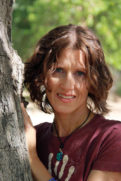
Colleen Dougherty
In April 2016, Jan van Hoof made a visit to his old friend of 40 years as she lay dying of old age. Their encounter and last hug between them was filmed and went viral in October 2017.
Van Hoof, a Dutch biologist and primatologist, had come to the Burgers Zoo in Arnhem, the Netherlands, to say goodbye to Mama, the matriarch of a troop of chimpanzees that he had known and studied for more than four decades.
Just shy of her 59th birthday, Mama had begun refusing food, and would lay in a fetal position on her nest of straw and wool, her eyes clouded with age. It took her a few moments to notice that van Hoof had come into her quarters, but when she did, she broke into a huge smile, turning her lips inside out as chimps are known to do when they’re extremely excited.
She reached out and put her arm around his neck, and the two patted each other’s heads, stroked each other’s faces, and chatted in soft hoots and grunts (chimpanzee language.) Mama died a week later.
A 2019 book, “Mama’s Last Hug,” by another Dutch primatologist, Frans de Waal, begins with the story of that tender moment between the matriarch and her longtime friend. De Waal also knew Mama, and remembers how film crews would wait for him whenever he went to visit her at the zoo, filming the moment when she noticed de Waal across the water moat and began to wave and come toward the fence, hooting and grunting in greeting. He found the media’s interest curious and disturbing.
“Anyone who knows chimpanzees realizes that they have excellent facial recognition and long memories, so what is so special about Mama being glad to see me?” He said it would be as if someone followed him to visit a human friend and filmed them opening the door and shouting “There you are!” “Who would be astonished?” he asks.
That astonishment and curiosity is what much of de Waal’s book is about. “… that we are impressed by Mama’s remembering me is a sign of humanity’s low opinion of animal emotional and mental capabilities.” In 1872, another famous author and scientist wrote a book titled “The Expression of the Emotions in Man and Animals.” That author was Charles Darwin.
The book is popular today, but back then was dismissed, and languished on shelves for more than a century. Why? Because the scientific community, as well as many in the general population, didn’t want to entertain the idea that animals, like us, are capable of feelings and emotions.
De Waal coined a term, “anthropodenial,” to describe the act of humans rejecting the presence of emotions in animals. It’s opposite, “anthropomorphism,” attributes “human-like” emotions and behavior to non-human animals or things. Interestingly, despite all the research people like Darwin, van Hoof and de Wall have done, those who anthropomorphize still get called “crazy” while those who anthro-deny are seen as “rational” or “scientific.”
For the past 10 years or so, there has been a blending of, or perhaps a battle between these two mindsets regarding the use of chimpanzees in scientific research. Since the 1920s, chimpanzees have been used in laboratories worldwide for medical and other types of experimentation. They lived in cages, were separated from their families and endured amputations, biopsies, blood draws and being injected with all sorts of diseases and chemicals.
In 2011, the European Union banned the use of laboratory chimps, citing humanitarian concern, lack of scientific validity and new modes of research not requiring animals. The U.S. lagged behind by two years, but finally bowed to pressure and ended the practice in 2013. Relocation efforts began to move the chimps (more than 500 nationwide, including here in New Mexico at Holloman Air Force Base in Alamogordo) to sanctuaries like Chimp Haven, the National Chimp Sanctuary in Louisiana.
But efforts stalled in 2015 as many were deemed “too sick or feeble” to travel. Sadly, many of their ills could be attributed to their experiences at the hands of mankind. Current efforts are underway to resume the relocation of these remaining chimps to sanctuaries, but it’s proving to be a tough battle.
A friend of mine actually saw video of two of the Alamogordo chimps who made it to Chimp Haven. Their joy over being out in the open, on grass, was reflected in their faces — in huge smiles, just like Mama’s. She said it made her wonder if that feeling of complete joy might actually be worth a few days of life.
















